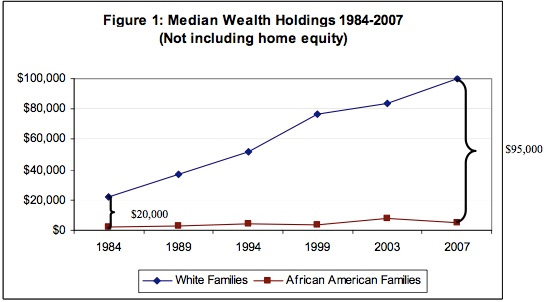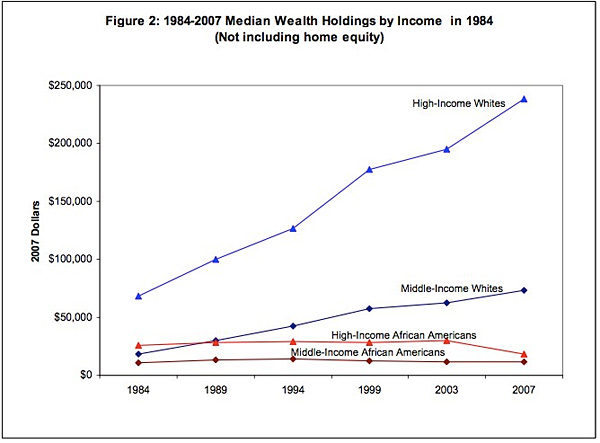
|  |  |  Editorials | Issues Editorials | Issues  
White Wealth and Black Debt Shot Up in "Growth" Years
 Kai Wright - RaceWire Kai Wright - RaceWire
go to original

The wealth gap between Blacks and Whites has grown by fourfold over the course of Generation X’s lifetime, exploding to $95,000, a study released this week found. And the debt burden among African American families has nearly doubled.

The study comes from Brandeis University’s Tom Shapiro, who’s among the pioneers in measuring economic equality by considering overall household wealth—your assets minus your debts—rather than just income. Shapiro’s research team looked at data from a decades-long, national survey of family economics and discovered that, between 1984 and 2007, the wealth gap saw unprecedented growth, as assets among high-income White households shot up while debt among all Black households did the same.

The visuals show it best. This first chart shows median assets by race (charts are from the report):


| | Median Wealth Holdings chart |  |
But a second chart breaks it down by income levels:


| | Median Wealth Holdings by Income chart |  |
So rich White people got really rich at the close of the 21st century. It puts the neo-liberal growth years into a new ligh - all that growth went into very few pockets. Meanwhile, Black folks’ debt shot up, too, as the lending market got less regulated and more perilous for working families. As Shapiro and his coauthors write:

| Among those with no financial assets, credit is often an emergency resource. Summing all assets and debt, one in ten African-Americans owe at least $3,600, while their debt burden was about half of this in real terms in 1984 ($2000). In sum, many African Americans hold more debt than assets. |

The problem of debt growth can’t be overstated. Yes, all Americans have drowned in the fees and trap doors federal regulators never thought twice about until this year. But Shapiro’s research points to why financial regulation is about a lot more still: Black neighborhoods in particular are awash in predatory financial products, ranging from subprime home loans to check cashing joints, and that has helped propel a lopsided and unsustainable economic trajectory. |

 |
|  |



